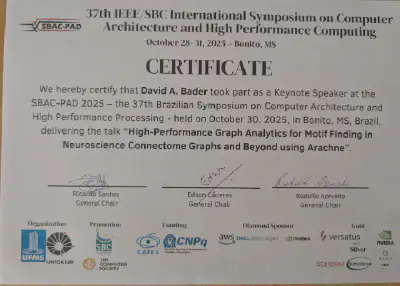High-Performance Graph Analytics for Motif Finding in Neuroscience Connectome Graphs and Beyond using Arachne

Abstract
The growth of network-structured data across domains like neuroscience and cybersecurity demands scalable graph analytics, but complex tasks like subgraph isomorphism remain accessible only to high-performance computing (HPC) specialists. Arachne is an open-source framework that democratizes high-performance graph analytics through a Python interface while abstracting parallelism complexities. It enables advanced graph algorithms to run efficiently from laptops to supercomputers. Arachne has been adopted by Harvard researchers for the MoMo connectome visualization tool, allowing neuroscientists to draw neural motifs that are translated into attributed subgraphs and searched using our novel HiPerMotif algorithm. Key innovations include HiPerMotif, which achieves up to 66× speedups over parallel approaches.Testing on large-scale datasets including FlyWire and the H01 human brain connectome demonstrates Arachne’s performance: completing complex subgraph searches in 38 seconds versus NetworkX’s 16,000+ seconds. This unified platform balances high-performance computation with accessibility, enabling researchers to extract insights from billion-scale graphs and advancing pattern matching across data-driven sciences.This research is supported in part by NSF grants CCF-2109988, OAC-2402560, and CCF-2453324.
| Date | Oct 30, 2025 11:00 AM – 12:00 PM |
| Event | 37th IEEE/SBC International Symposium on Computer Architecture and High Performance Computing (SBAC-PAD) |
| Location | Bonito, Mato Grosso do Sul, Brazil |

Bio: David A. Bader is a Distinguished Professor and founder of the Department of Data Science and inaugural Director of the Institute for Data Science at New Jersey Institute of Technology. Prior to this, he served as founding Professor and Chair of the School of Computational Science and Engineering, College of Computing, at Georgia Institute of Technology. Bader is an appointed member of the NIH National Heart, Blood, and Lung Institute Advisory Council, is an elected Board Member of the Computing Research Association (CRA), and previously served on the IEEE Computer Society Board of Governors. Dr. Bader is a Fellow of the IEEE, ACM, AAAS, and SIAM; a recipient of the IEEE Sidney Fernbach Award; the 2022 Innovation Hall of Fame inductee of the University of Maryland’s A. James Clark School of Engineering; a 2025 inductee of the Mimms Museum of Technology and Art’s Hall of Fame; and the 2025 recipient of the Heatherington Award for Technological Innovation. He advises the White House, most recently on the National Strategic Computing Initiative (NSCI) and Future Advanced Computing Ecosystem (FACE). Bader is a leading expert in solving global grand challenges in science, engineering, computing, and data science. His interests are at the intersection of high-performance computing and real-world applications, including cybersecurity, massive-scale analytics, and computational genomics, and he has co-authored over 400 scholarly papers and has best paper awards from ISC, IEEE HPEC, and IEEE/ACM SC. Dr. Bader has served as a lead scientist in several DARPA programs including High Productivity Computing Systems (HPCS) with IBM, Ubiquitous High Performance Computing (UHPC) with NVIDIA, Anomaly Detection at Multiple Scales (ADAMS), Power Efficiency Revolution For Embedded Computing Technologies (PERFECT), Hierarchical Identify Verify Exploit (HIVE), and Software-Defined Hardware (SDH). Recently, Bader received an NVIDIA AI Lab (NVAIL) award, and a Facebook Research AI Hardware/Software Co-Design award. Dr. Bader has previously served as the Editor-in-Chief of the ACM Transactions on Parallel Computing, and as Editor-in-Chief of the IEEE Transactions on Parallel and Distributed Systems. He serves on the leadership team of Northeast Big Data Innovation Hub as the inaugural chair of the Seed Fund Steering Committee. ROI-NJ recognized Bader as a technology influencer on its 2021 inaugural and 2022 lists. In 2012, Bader was the inaugural recipient of University of Maryland’s Electrical and Computer Engineering Distinguished Alumni Award. In 2014, Bader received the Outstanding Senior Faculty Research Award from Georgia Tech. Bader is a member of Tau Beta Pi (National Engineering Honor Society), Eta Kappa Nu (Electrical Engineering Honor Society), and Omicron Delta Kappa (National Leadership Honor Society). Bader has also served as Director of the Sony-Toshiba-IBM Center of Competence for the Cell Broadband Engine Processor and Director of an NVIDIA GPU Center of Excellence. In 1998, Bader built the first Linux supercomputer that led to a high-performance computing (HPC) revolution, and Hyperion Research estimates that the total economic value of Linux supercomputing pioneered by Bader has been over $100 trillion since its inception. The Computer History Museum recognizes Bader for developing the first Linux-based supercomputer which became the predominant architecture for all major supercomputers in the world. Bader is a cofounder of the Graph500 List for benchmarking “Big Data” computing platforms. He is recognized as a “RockStar” of High Performance Computing by InsideHPC and as HPCwire’s People to Watch in 2012 and 2014. In 2025, HPCwire named Bader as one of its “35 Legends”. For more information, please visit https://davidbader.net/